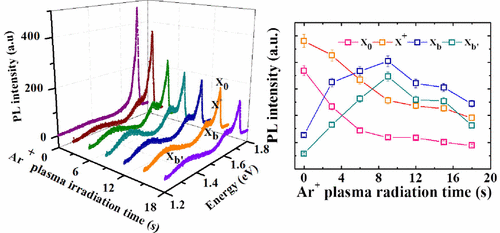当前位置:
X-MOL 学术
›
J. Phys. Chem. C
›
论文详情
Our official English website, www.x-mol.net, welcomes your
feedback! (Note: you will need to create a separate account there.)
Defect Activated Photoluminescence in WSe2 Monolayer
The Journal of Physical Chemistry C ( IF 3.3 ) Pub Date : 2017-05-18 00:00:00 , DOI: 10.1021/acs.jpcc.7b03585
Zhangting Wu 1 , Weiwei Zhao , Jie Jiang , Ting Zheng , Yumeng You , Junpeng Lu , Zhenhua Ni 1
The Journal of Physical Chemistry C ( IF 3.3 ) Pub Date : 2017-05-18 00:00:00 , DOI: 10.1021/acs.jpcc.7b03585
Zhangting Wu 1 , Weiwei Zhao , Jie Jiang , Ting Zheng , Yumeng You , Junpeng Lu , Zhenhua Ni 1
Affiliation

|
Defects in transition metal dichalcogenides (TMDs) play an important role in tailoring electrical and optical properties. Here we employ Ar+ plasma to controllably generate active defects in WSe2 monolayers to tune their optical properties. Two defect-activated PL emission peaks are emerging in the low temperature PL spectra of WSe2 monolayer treated with Ar+ plasma. These emissions are attributed to the recombination of excitons bound to different types of structural defects. The shallow level emission originates from the recombination of excitons at chalcogen vacancies, while the deep level emission might arise from other types of defects, such as transition metal vacancies, cluster of vacancies, rotational defects, or antisite defects. Our results demonstrate that Ar+ plasma treatment is an effective approach to induce desirable defects in TMDs monolayers and PL spectroscopy is an efficient method to investigate these defects.
中文翻译:

WSe 2单层中的缺陷激活的光致发光
过渡金属二硫化碳(TMDs)中的缺陷在调整电学和光学特性方面起着重要作用。在这里,我们采用Ar +等离子体可控地在WSe 2单层中生成有源缺陷,以调整其光学性能。Ar +处理的WSe 2单层的低温PL光谱中出现两个缺陷激活的PL发射峰等离子体。这些排放归因于与不同类型的结构缺陷结合的激子的复合。浅能级发射来自硫属元素空位处激子的复合,而深能级发射可能来自其他类型的缺陷,例如过渡金属空位,空位簇,旋转缺陷或反位缺陷。我们的结果表明,Ar +等离子体处理是在TMDs单层中诱导理想缺陷的有效方法,而PL光谱法是研究这些缺陷的有效方法。
更新日期:2017-05-27
中文翻译:

WSe 2单层中的缺陷激活的光致发光
过渡金属二硫化碳(TMDs)中的缺陷在调整电学和光学特性方面起着重要作用。在这里,我们采用Ar +等离子体可控地在WSe 2单层中生成有源缺陷,以调整其光学性能。Ar +处理的WSe 2单层的低温PL光谱中出现两个缺陷激活的PL发射峰等离子体。这些排放归因于与不同类型的结构缺陷结合的激子的复合。浅能级发射来自硫属元素空位处激子的复合,而深能级发射可能来自其他类型的缺陷,例如过渡金属空位,空位簇,旋转缺陷或反位缺陷。我们的结果表明,Ar +等离子体处理是在TMDs单层中诱导理想缺陷的有效方法,而PL光谱法是研究这些缺陷的有效方法。

































 京公网安备 11010802027423号
京公网安备 11010802027423号